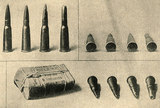Prohibited war material: Dum-dum shells and deployment of gas
"The warring parties do not have unlimited rights in the choice of means to damage the enemy." This is stated in Article 22 of the Hague Land War Convention. The fact that the war participants – from the individual soldier to the commanders-in-chief – acted here ‘more liberally’ than permitted by the law of war is shown by the use of dum-dum shells and toxic gas.
The warring parties accuse one another of using ‘weapons, shells or materials which tend to cause unnecessary suffering’. The use of materials of this kind was strictly forbidden according to Article 23(e) of the Hague Land War Convention (HLWC). Examples of the illegitimate means of fighting were the devastating exploding and dum-dum shells, inflicting severe injuries on those affected on account of the tearing and disfigurement it caused. Each side accused its opponents of its deployment – only for the opponent to vehemently deny it. It is certain, however, that dum-dum shells were in use due to the sheer multitude of the most grievous shell injuries and remnants of bullets. These days it is broadly undisputed that the deployment of these shells was not systematically ordered by any of the parties waging war. That such missiles were nonetheless employed stems from the fighting soldier himself: in order to inflict the worst possible injuries on the enemy, some of them manipulated the munitions handed out to them. Technically this change was most simple to achieve: all that was needed was to cut a groove or flatten out the ends of the projectiles so as to make a deformation shell from a full metal jacket.
One further point of contention between the belligerent parties was the use of poisonous gas. The deployment of ‘poison or poisoned weapons’ was clearly prohibited according to Article 23(a) of the HLWC. Yet some commentators interpreted the legal requirements in such a way that only the insidious use of gas was contrary to international law. Open use, so they argued, was to be seen as legitimate in comparison. Although this was explicitly rejected by the majority of legal experts, the warring parties ultimately did deploy these weapons. The taboo was first broken – with fatal consequences – by German troops on April 22, 1915 at Ypres (Belgium), when chlorine gas was deployed against a British position. This set off a chain of events that was questionable from the international law perspective. For although the Allies recognised poisonous gases as a cruel and illegitimate means of waging war, they themselves employed it from autumn 1915 onwards. The argument for this step was that its use represented an equivalent reprisal. Although this term was not allowed for in the HLWC, it was a matter of general consensus among the belligerent nations that reprisals were legitimate as a "[...] response to similar violations of international law previously carried out by the opponent in war."
Through the legal form of the reprisal, the law of war, if once violated by one of the belligerent parties, could be cancelled out at any time by one of the others. The fact that this also occurred was shown both by the chemical gas deployments as well as the air bombardment that likewise were contrary to the law of war. Thus for their part the French reacted to German bombing of the cities of Bar-le-Duc, Amiens, Reims or Saint-Dié with equivalent bombardments of Freiburg, Trier, Stuttgart and Karlsruhe.
Kramer, Alan: Kriegsrecht und Kriegsverbrechen, in: Hirschfeld, Gerhard/Krumreich, Gerd/Renz, Irina (Hrsg.): Enzyklopädie Erster Weltkrieg, 3. Auflage, Paderborn/München/Wien/et al. 2009, 281-292
Liszt, von Franz: Das Völkerrecht, bearb. von Max Fleischmann, 12. Auflage, Berlin 1925
Lexikalische Einträge zu Dumdumgeschossen und Giftgas in: Hirschfeld, Gerhard/Krumreich, Gerd/Renz, Irina (Hrsg.): Enzyklopädie Erster Weltkrieg, 3. Auflage, Paderborn/München/Wien/et al. 2009, 450/519
Martinetz, Dieter: Vom Giftpfeil zum Chemiewaffenverbot. Zur Geschichte der chemischen Kampfmittel, Frankfurt/Main 1995
Quotes:
"[...] response to similar violations...": Liszt, von Franz: Das Völkerrecht, bearb. von Max Fleischmann, 12. Auflage, Berlin 1925, 457 (Translation)
-
Chapters
- International laws of war. Genesis of a juridification
- The First World War and the law on war in effect
- The Western front. Guerilla poses and war waged on the civilian population
- Russia’s ‘enemies within’. Jewish and German minorities on the Eastern Front.
- The war crimes of the Habsburg army. Between soldateska and court martial.
- War imprisonment. The right "to be treated with humanity"
- Prohibited war material: Dum-dum shells and deployment of gas
- The Leipzig Trials (1921-1927). Between national disgrace and juridical farce







